A Poa annua Conspiracy: Nation-wide Golf Course Evaluation Trials
Historic Bowman Field Earns 2023 Field of Distinction Award
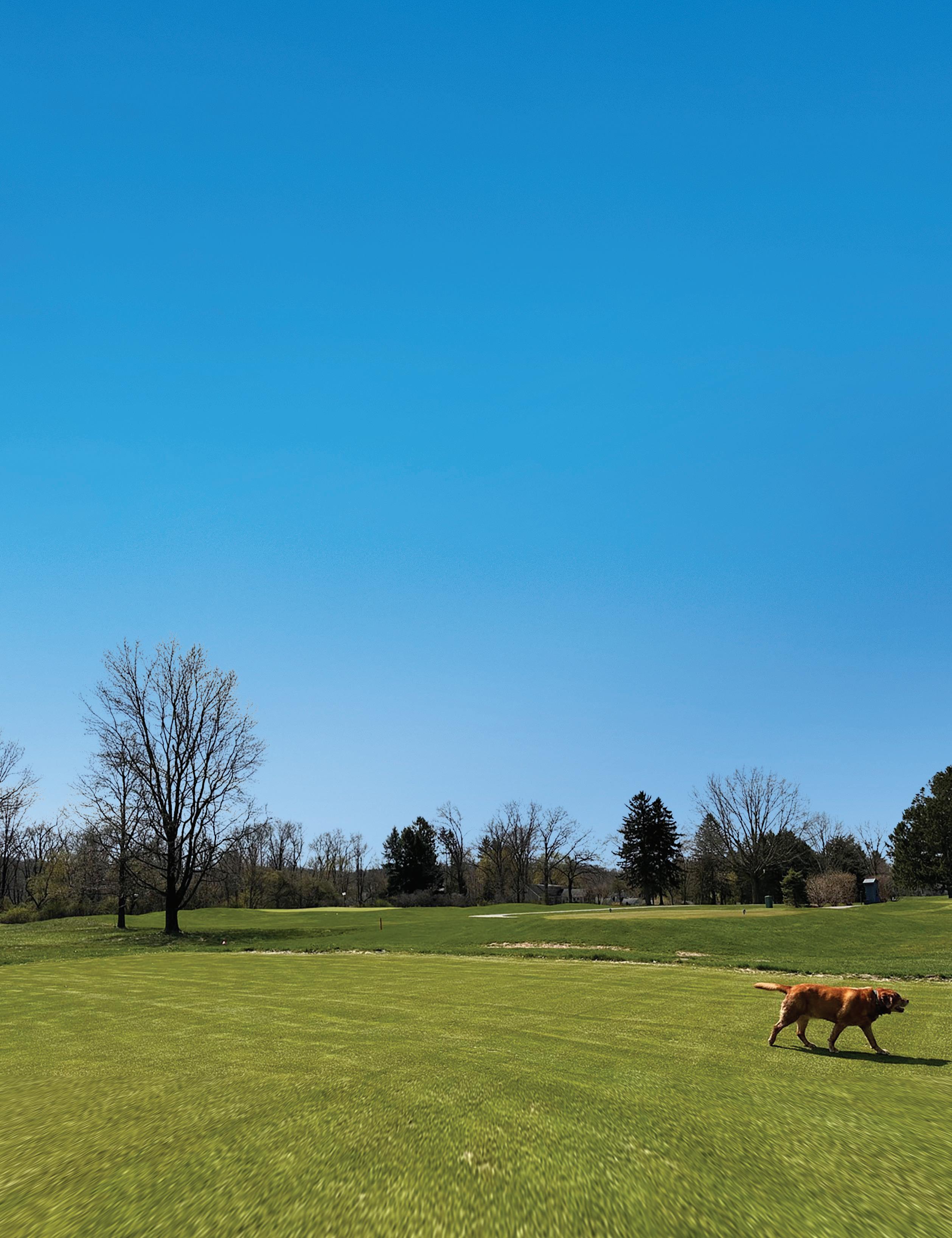
Summer 2023 • Vol. 12 / No. 3


TAK E YOUR TURF TO THE NE XT LEVEL W I TH.. . Cont ac t Fish er & S on Compa ny toda y to provid e you wi th the too ls an d exp erti s e for all ReG ene rate p roduct s to exce ed y our t urf and horticultu re exp ectati ons. A proprietary soil surfactant designed to Reduce LDS Enhance Irrigation Efficiency Reduce Plant Stress Thom Mahute - 717-940-0730 Bob Seltzer - 610-704-4756 Dave Hunley - 215-262-3912 Zach Owen - 609-454-7727 ✓ ✓ ✓
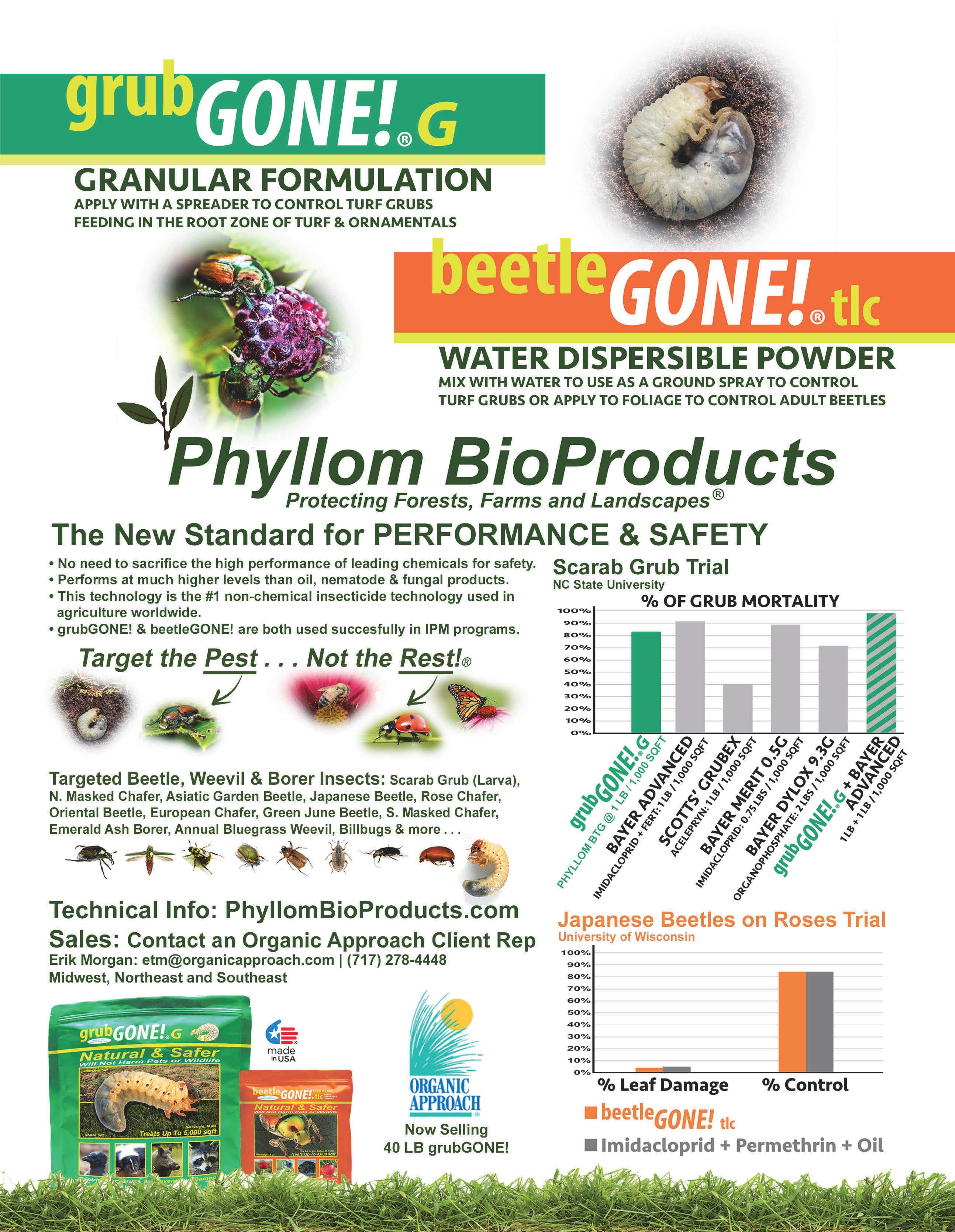
Pennsylvania Turfgrass Council P.O. Box 99 Boalsburg, PA 16827-0550
Phone: (814) 237-0767
Fax: (814) 414-3303
info@paturf.org
www.paturf.org
Publisher: Leading Edge Communications, LLC 206 Bridge Street, Suite 200 Franklin, TN 37064
Phone: (615) 790-3718
Fax: (615) 794-4524 info@leadingedgecommunications.com
Pennsylvania Turfgrass Editor
Max Schlossberg, Ph.D. Penn State University • mjs38@psu.edu
Conferences and Education Manager
Kristen Althouse
Pennsylvania Turfgrass Council
President
Rick Catalogna Harrell’s Inc Territory Manager (412) 897-0480
Secretary-Treasurer
Shawn Kister Longwood Gardens, Inc. –Kennett Square, PA (484) 883-9275
Past President
Tom Fisher Wildwood Golf Club – Allison Park, PA (412) 518-8384
Director of Operations
Tom Bettle
Penn State University
Directors
Steve Craig Centre Hills Country Club
Tanner Delvalle
Penn State Extension
Elliott Dowling USGA
Andy Moran
University of Pittsburgh
Tim Wilk
Scotch Valley Country Club
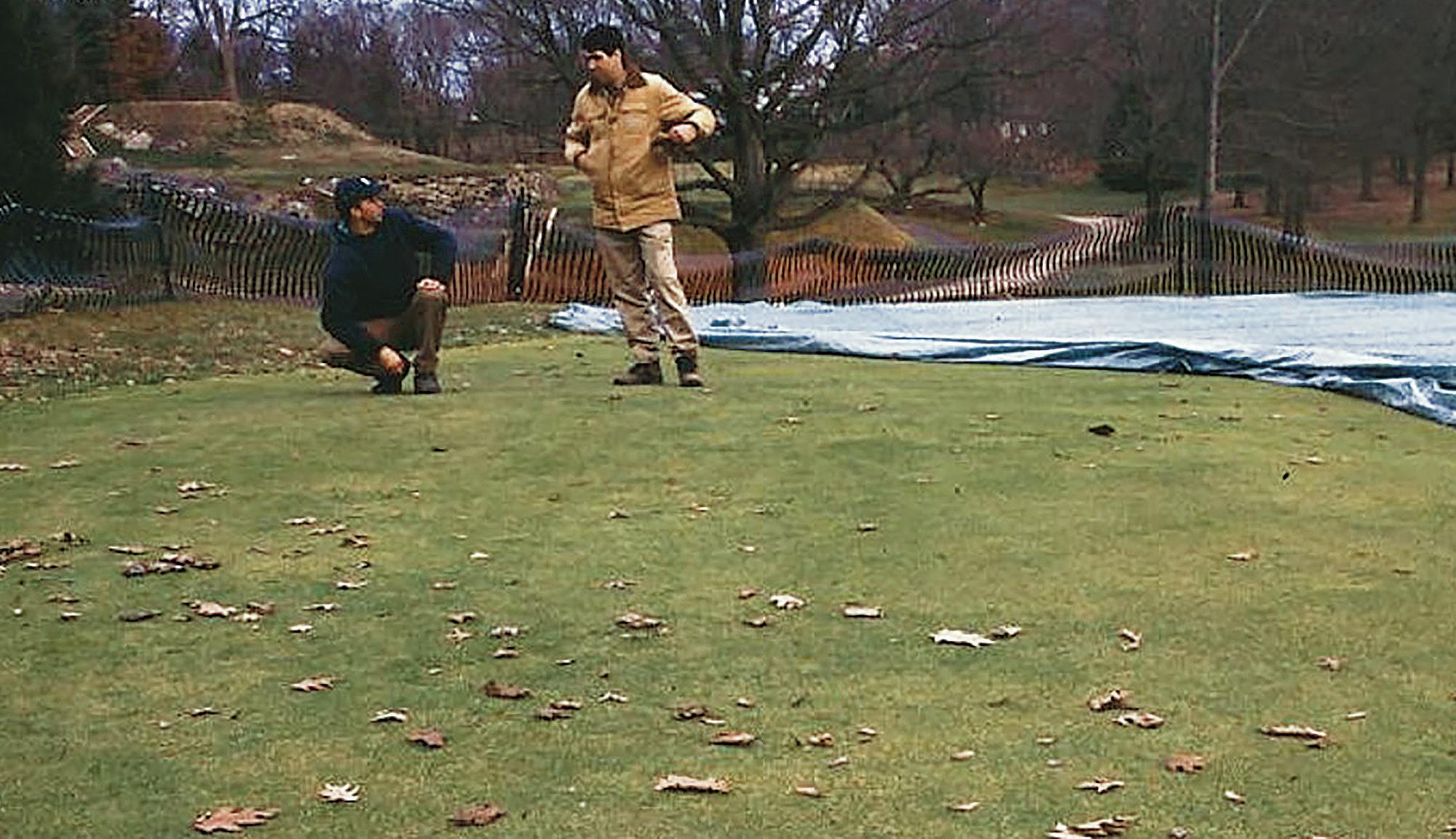
Matt Wolf
Penn State University
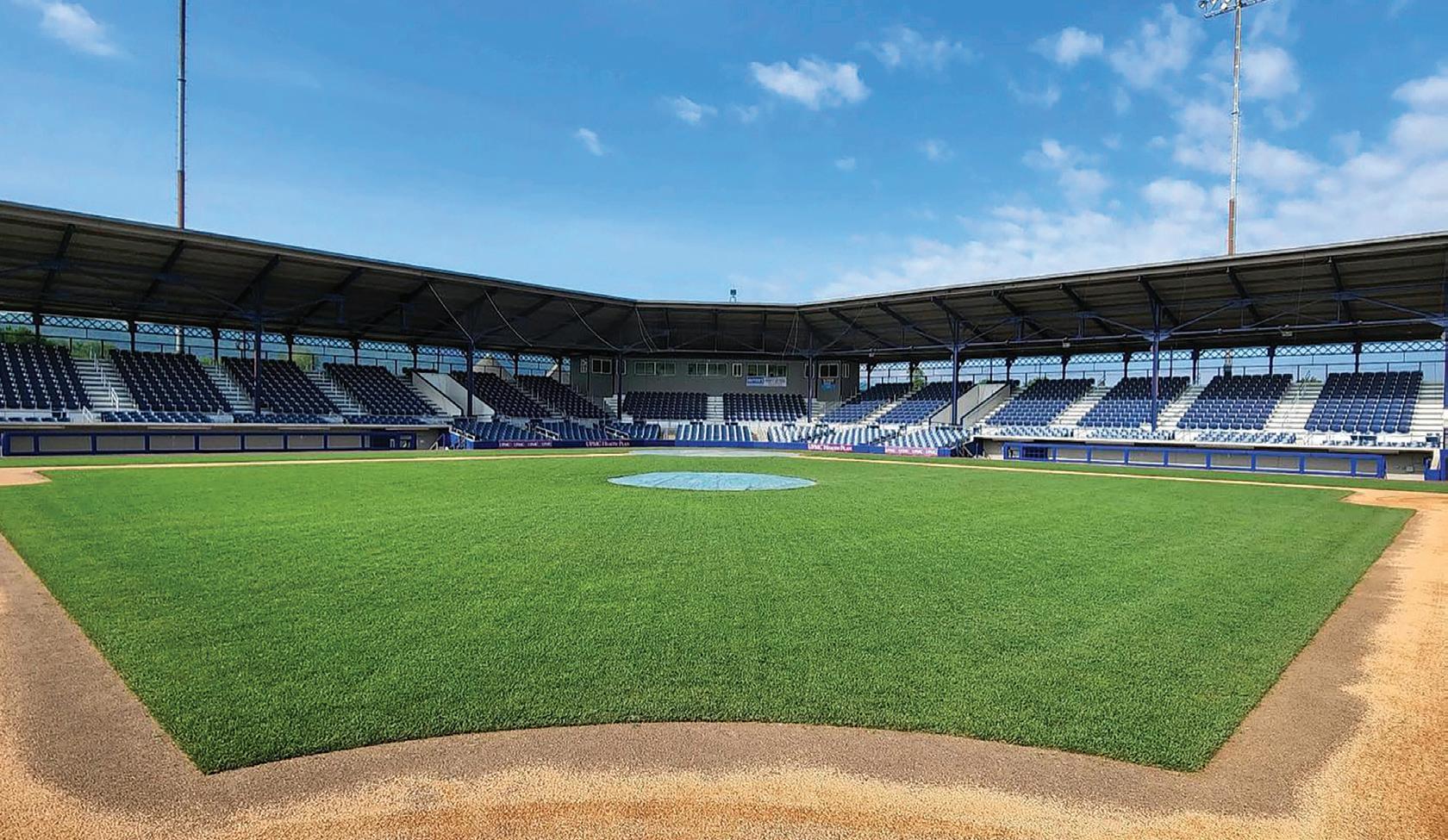
4 Pennsylvania Turfgrass • Summer 2023 24 8 Vol. 12 / No. 4 • Summer 2023 5 Advertiser Index 6 President’s Update 6 Penn State Turf Team 22 Penn State News 14 Origins of Turf, Part 1 8 A Poa annua Conspiracy: Nation-wide Golf Course Evaluation Trials 24 Historic Bowman Field Earns 2023 Field of Distinction Award 26 The Manager’s Dilemma Between the Lines Feature Cover Story Departments Professional Development
Find this issue, Podcasts, Events and More: THETURFZONE.COM
The Pennsylvania Turfgrass Council (PTC) serves its members in the industry through education, promotion and representation. The statements and opinions expressed herein are those of the individual authors and do not necessarily represent the views of the association, its staff, or its board of directors, Pennsylvania Turfgrass, or its editors. Likewise, the appearance of advertisers, or PTC members, does not constitute an endorsement of the products or services featured in this, past or subsequent issues of this publication. Copyright © 2023 by the Pennsylvania Turfgrass Council. Pennsylvania Turfgrass is published quarterly. Subscriptions are complimentary to PTC members. Presorted standard postage is paid at Jefferson City, MO. Printed in the U.S.A. Reprints and Submissions: Pennsylvania Turfgrass allows reprinting of material published here. Permission requests should be directed to the PTC. We are not responsible for unsolicited freelance manuscripts and photographs. Contact the managing editor for contribution information. Advertising: For display and classified advertising rates and insertions, please contact Leading Edge Communications, LLC, 206 Bridge Street, Suite 200, Franklin, TN 37064, (615) 790-3718, Fax (615) 794-4524.
Our warehouses are fully stocked and ready to meet your seeding needs with our extensive selection of turfgrasses and seeding supplies, ready to be prepared and delivered to suit your needs.

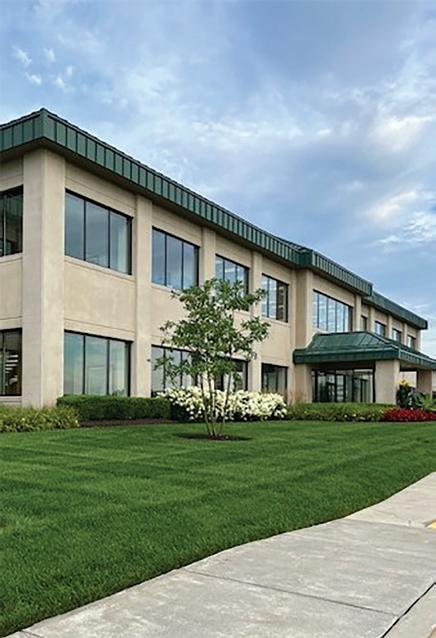

5 Summer 2023 • Pennsylvania Turfgrass Advertiser Index Aer-Core, Inc. 21 www.aer-core.com Burlingham Seeds 7 www.burlinghamseeds.com Coombs Sod Farms 5 www.coombsfarms.com Covermaster, Inc. 11 www.covermaster.com DryJect 17 East Coast Sod & Seed 6 www.eastcoastsod.com Fisher & Son Company, Inc. Inside Front Cover www.fisherandson.com FM Brown’s & Sons 5 www.fmbrown.com Forse Design Incorporated 19 www.forsegolfdesign.com George E. Ley Co. 13 www.gelcogolf.com Greene County Fertilizer Co. 13 www.greenecountyfert.com Lawn & Golf Supply Back Cover www.planetair.biz Phyllom BioProducts ........................ 3 www.phyllombioproducts.com Progressive Turf Equipment Inc. ..... 21 www.progressiveturfequip.com Seedway 5 www.seedway.com Shreiner Tree Care 13 www.shreinertreecare.com Smith Seed Services 11 www.smithseed.com STEC Equipment 23 www.stecequipment.com The Turf Trade
Back Cover www.theturftrade.com
Inside
LIFE IS COMPLICATED — SEED DOESN’T HAVE TO BE — WE MAKE SEED EASY. 797 Commerce Street Sinking Spring, PA 19608 Phone: 800-345-3344 SeedInfo@FMBrown.com
OFF AND RUNNING
Jeffrey A. Borger
Senior Instructor in Turfgrass Weed Management
814-865-3005 • jborger@psu.edu
Michael A. Fidanza, Ph.D.
Professor of Plant & Soil Science 610-396-6330 • maf100@psu.edu
The
season has started for all of us, no matter which segment of this industry you are in. This issue won’t release until June and it’s tough to gauge where we might be or what we might be doing this summer. I know in my years as a superintendent and now as a sales professional that some things, no matter what time of the year, never change. Our devotion to doing the best job possible for ourselves, for members or more importantly our families, is as strong as ever. We make product, equipment and staffing decisions to give us the best season we can strive for. In doing all this preparation and fueling that love for the industry, we can lose out on simple things. How about planning a day with the family? How about a dinner after work with an old friend? These don’t take much planning or effort and yet they become very hard things to accomplish amid the hustle and bustle of the season.
This season, no matter what preparation we all took to make it successful, I hope we all allocate the necessary time to reconnect. With our staff, family, friends and old colleagues. Take time to appreciate everything around us. Just call a friend out of the blue and make their day. ‘It takes an army,’ but you never know what army of support you have if you don’t make time to reach out. Now on the sales side, I see how burned out this season makes us all. We are in our own routines, on our own properties and we are constantly looking at the same things. I say it’s our own bubble, but if we can just make a call or even an easy text to stay connected, we will see that we are in the same community dealing with the same issues and all need a friendly voice or sympathetic ear to get us through it.
The season is tough enough on us all! Let’s try and get through it together.
Richard R. Catalogna PTC President

David R. Huff, Ph.D.
Professor of Turfgrass Genetics 814-863-9805 • drh15@psu.edu
Brad Jakubowski Instructor of Plant Science 814-865-7118 • brj8@psu.edu
John E. Kaminski, Ph.D. Professor of Turfgrass Science 814-865-3007 • jek156@psu.edu
Peter J. Landschoot, Ph.D. Professor of Turfgrass Science 814-863-1017 • pjl1@psu.edu
Ben McGraw, Ph.D. Associate Professor of Turfgrass Entomology 814-865-1138 • bam53@psu.edu
Andrew S. McNitt, Ph.D. Professor of Soil Science 814-863-1368 • asm4@psu.edu
Max Schlossberg, Ph.D. Associate Professor of Turfgrass Nutrition / Soil Fertility 814-863-1015 • mjs38@psu.edu
SPECIALIZING
KEVIN DRISCOLL CELL: 609-760-4099 OFFICE: 856-769-9555
KDRISCOLL@EASTCOASTSOD.COM
Al J. Turgeon, Ph.D. Professor Emeritus of Turfgrass Management aturgeon@psu.edu

6 Pennsylvania Turfgrass • Summer 2023 President’s Update Penn State Turf Team
IN BENTGRASS SOD FOR GREENS, TEES, & FAIRWAYS FINE AND TALL FESCUE REGULAR AND SHORTCUT BLUEGRASS
DIGITAL MARKETPLACE: Scan the QR Code to learn more about this company.


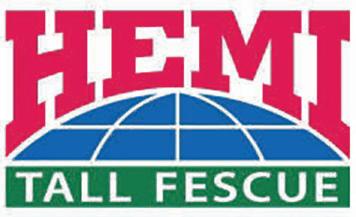
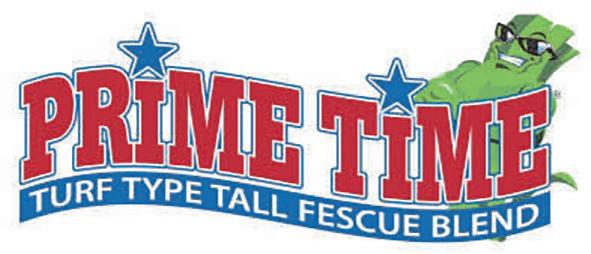
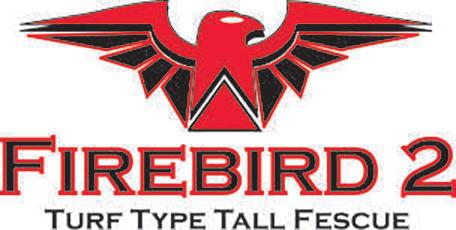
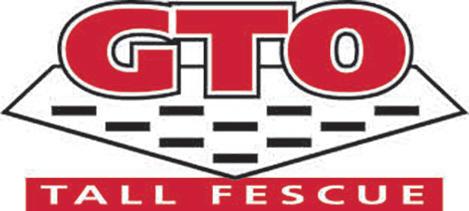

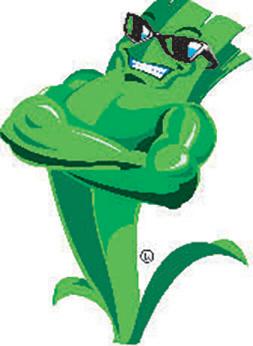

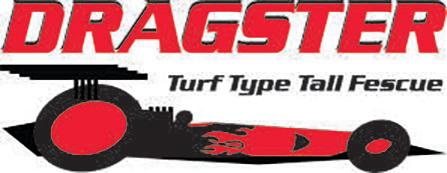


www.ntep.org For test results check www.burlinghamseeds.com
A POA ANNUA CONSPIRACY
Nation-wide Golf Course Evaluation Trials

Cover Story 8 Pennsylvania Turfgrass • Summer 2022
Wildwood CC’s assistant-superintendent “Abby” inspects a newly established Pa-33 Poa annua nursery.
By David R. Huff, Ph.D., Professor, Penn State University
Even in the current era of elaborate conspiracy theories and stories of bird-like aliens, and others having secret military bases on the dark side of the moon, it’s hard to imagine anything as contentious as Poa annua in today’s golf industry. For example, contrary to a recent survey that claims Poa annua is the golf industry’s third-most popular (aka abundant) turfgrass species (Golf Course Environmental Profile, 2017), most superintendents are committed to eradicating it. Conversely, despite Poa annua being the only turfgrass species in use that lacks any improved varieties and exists solely as local land races, a majority of the best golf courses strive to propagate it (https://www.top100golfcourses.com). For the past 100 years, the controversial ‘friend vs foe’ status of Poa annua has heavily favored its eradication. However, it is now time to begin exploring the best management practices (BMPs) for its propagation. That’s because soon a commercial seed source of improved varieties that have been specifically bred for use on greens and fairways will become available (see Huff, 2022). In this article, we’ll explore the grow-in of a 2022 golf course evaluation trial of Poa annua on greens and fairways.

TESTING TRIALS
One of the first steps that needs to be undertaken during the release of any new variety of turfgrass is its evaluation at different locations, which I initiated with experimental varieties from my Penn State Poa annua breeding program back in the early 2000’s (see for example, Mitra et al., 2009). I first trialed my experimental Poa annua varieties back in 2002 at Apawamis GC, Rye, NY (Fig. 1). Superintendent Bill Purdy had just harvested sod from three of his Poa greens to enlarge his remaining 15 Poa greens, and then used Penn State Poa seed to reseed his three bare greens. Establishment went well and his members were thrilled with the results. However, about 10 years later, we realized that the problem with Poa annua commercialization was not varietal development but rather varietal instability during seed production, and it took another seven years of research after that to solve the problem. During those intervening years, Superintendent, Michael McCormick (Apawamis superintendent from 2016-2022; currently, superintendent at Oakmont CC, PA) observed that those Penn Poa greens were more tolerant of biotic and abiotic stress and used less water than the other 15 greens of the local Poa. Now that we’ve solved the commercial seed production problem and are able to produce seed of phenotypically stable Poa annua, I’ve organized a new evaluation trial of the final commercial seed product at six trial locations which includes golf courses on the East & West Coasts and from the Northern to Southern Appalachian Mountains ( Fig 2. ).
1.
State Poa
took place at Apawamis GC, Rye, NY (just outside of NYC) in 2002. Picture: Six-month old Poa green (planted Sept. 2002). Superintendent Bill Purdy (pictured standing) harvested sod from 3 greens to enlarge his remaining 15 greens, then used Penn State Poa seed to reseed his 3 bare greens (2002). Since then, Superintendent Michael McCormick (Apawamis superintendent from 2016–2022; currently, superintendent at Oakmont CC) observed that those Penn Poa greens were more tolerant of biotic and abiotic stress and used less water then the other 15 greens of the local Poa.

9 Summer 2022 • Pennsylvania Turfgrass
FIG .
The first golf course planting of Penn
annua varieties
FIG. 2. The six test sites comprising the 2022 Evaluation Trial of Pa-33 Poa annua greens and fairways range from the East to West Coasts and from the Northern to the Southern Appalachian Mountains.
2022 ‘Pa-33’ Poa annua Trial test-site locations
This new 2022 Poa annua trial has now been established at five of the six trial locations, with the Cypress Point Club (CA) trial (delayed due to weather and events) to be established in July 2023. The following are some early observations of establishment and grow-in of Poa




at these sites.
SEEDING RATES
Early in the breeding program there was never enough seed to plant the areas we needed to establish, so we had to stretch seedings to their maximum lowest rates in order to plant the largest possible sized areas we could. As such, we’ve planted greens as low
as 0.3lb/K, but those areas took an entire growing season to properly fill in. We eventually settled on a 1lb/K seeding rate which is a relatively low seeding rate for Poa, but after a fall planting, it gave us an opportunity to watch the experimental varieties complete their grow-in during the following spring and we had full stands
10 Pennsylvania Turfgrass • Summer 2022
annua
Cover Story • continued
FIG . 3. Pa-33 Poa annua planted June 12, 2022 @ Apawamis GC (NYC). Main and small right inset photos: 8-week-old (June 12August 12), summer planting, mowed at 0.365". Large left inset photo: 25-week-old (June 12-December 6), 0.25" mowing height.
FIG . 4. Pa-33 Poa annua planted September 25, 2023 @ Highlands CC (NC). Main and inset photos: 24-week-old (Sept 25-April 13) nursery. Highlands is at 4,180’ elevation and so the late fall planting and cold early spring weather have slowed establishment but with some warm weather, added fertility, and close mowing, this nursery area will fill in nicely.
FIG . 6. Pa-33 Poa annua seeded Sept. 9, 2022 @ Wildwood CC (PA). Main and inset photos: 28-weeks old, mowed 0.20", top-dressed.
FIG . 5. Pa-33 Poa annua seeded Nov 8, 2022 @ Laurel Creek CC (NJ). Main and inset photos: 20-week-old, mowed at 0.300". Late fall organic fertilization, covers on & off throughout winter.
to evaluate over their first summer. Personally, I prefer low seeding rates because it results in strong, healthy seedlings as compared to extremely high seeding rates (> or = 3lbs/K) which results in overly dense, weak seedlings that encourage diseases like damping off disease (caused by Pythium and/or Rhizoctonia) due to interplant competition, low light, and poor air circulation. For the 2022 Poa Trial, we increased the seeding rate to 1.25-1.3lb/K, however, in hindsight, I would’ve liked to have increased this rate to 1.75-2.0 lb/K, which I think is a good compromise between healthy seedlings and rapid establishment.
PLANTING DATES
A range of planting dates have been a natural outcome of the various trial locations, and we’ve found that the Pa33 Poa annua variety is capable of becoming established at any dates we’ve planted throughout the year. The new Apawamis GC (NYC) trial was planted June 12, 2022, and thus grow-in took place over the warm, humid summer (Fig. 3). The Highlands CC (NC) location, however, was planted on September 25, 2022, which is very late owing to the fact that Highland, NC is one of the highest cities east of the Mississippi at 4,180’ elevation. Thus, Highland’s grow-in started with temperatures in the 30’s & 40’s F, and with the cold spring weather, has never really experienced any warm temperatures right up to the time of writing this article (Fig. 4). Despite these cold temperatures, Pa-33 has become established and the Highland’s nursey area will fill in nicely with some warm weather, added fertility, and close mowing. Laurel Creek CC (NJ), just outside of Philadelphia, also had a late season planting on November 8, 2022 (Fig. 5). However, a late fall fertilization of organics on December 8 and playing the on/off game with covers throughout the winter enable the green to fully grow in by March 13, 2023 (pictured). The remaining two locations (Wildwood CC & Penn State) both were planted on September 9, 2022 (Figs. 6 & 7). While both these sites are similar in elevation and fall/ winter/spring temperatures, their difference in establishment seems to be primarily related to differences in mowing heights during the initial period of establishment.
Our lightweight EVERGREEN™Turf Covers produce a greenhouse type effect that allows your turf to breathe and retain the right amount of heat and moisture.
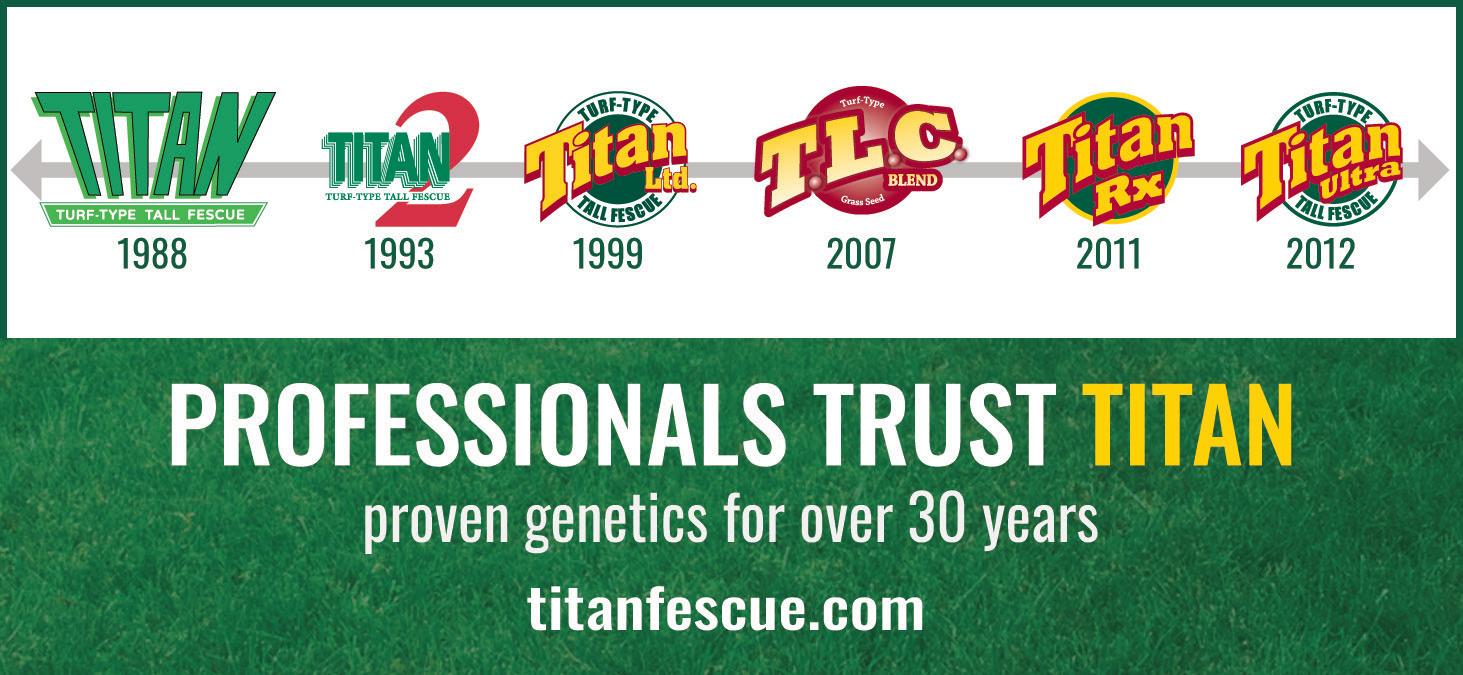
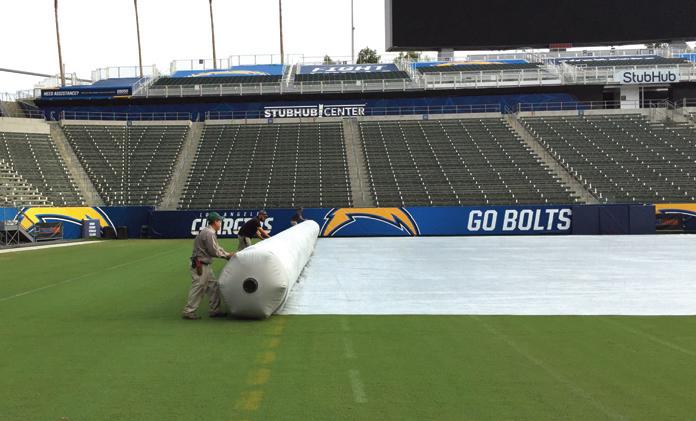
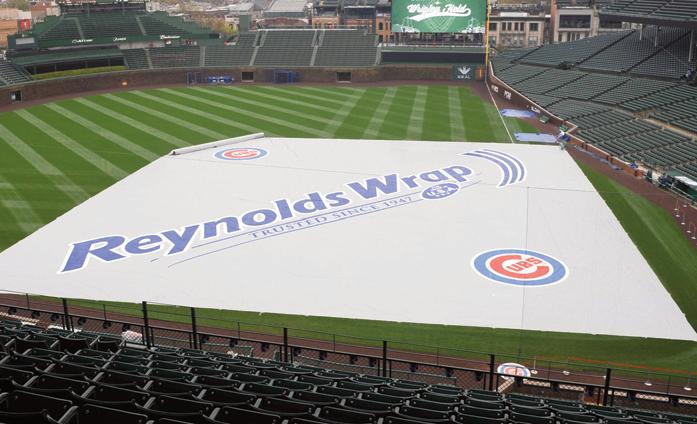
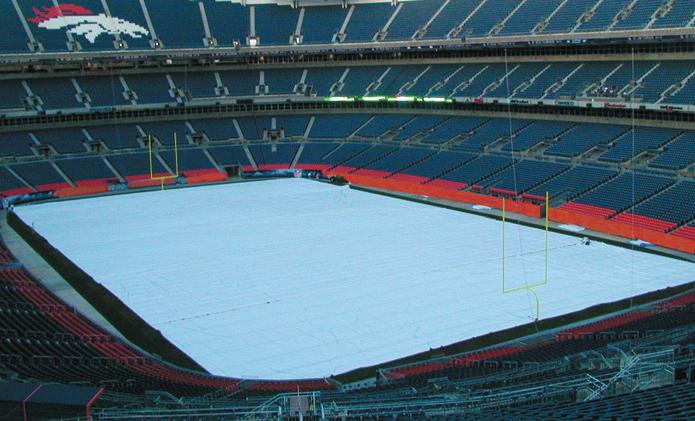
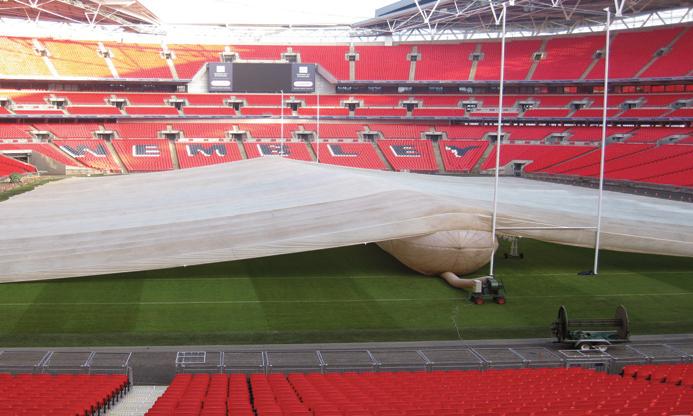

Covers That Make
Difference
the
RAINCOVERS, from our supreme lightweight ones right to the classic vinyl types, there are models and accessories to meet your specific needs
TARPMATE™ AIR roller is a revolutionary storage and handling system for field covers. 2-3 people can roll out or roll up a 100’ wide cover.
An INFLATABLE FIELD COVER allows for ongoing field maintenance during inclement and extreme cold weather.
FOOTBALL FIELD COVERS are made of superior strength material, providing protection from rain or snow.
100 Westmore Dr., 11D, Rexdale, ON M9V 5C3 3909 Witmer Rd., Niagara Falls, NY 14305 1-800-387-5808 Tel: +1-416-745-1811 • Fax: +1-416-742-6837 www.covermaster.com • info@covermaster.com MASTER BRANDING 11 Summer 2022 • Pennsylvania Turfgrass
MOWING
One of the more interesting observations made in the 2022 trial to date involves mowing height differences during initial seedling establishment. All of the trial locations, except for Penn State, established their Poa annua under an initial mowing height of 0.30 – 0.35" for the first several months and, by months five or six, had only reduced the height-of-cut down to 0.25". Whereas at Penn State, we had already achieved a 0.125" heightof-cut by 6.5 weeks after planting and had vertical mowed in two-directions by that time (Fig. 7). Even though the Penn State green was not completely filled-in by 6.5 weeks, the aggressive mowing practices seemed to encourage substantial lateral growth resulting in a puttable surface by 10 to 12 weeks after planting.
No management instructions were given to the trial superintendents prior to planting, so each was left to manage their establishment as best they saw fit. Thus, it was curious to me that such a wide range of experience and locations all managed the Poa establishment so similarly. It was only when Elliott L. Dowling, USGA Regional Director, East Region, had commented that it seemed as though all of these superintendents were managing their Poa grow-in as though it were creeping bentgrass that it dawned on me that no one has actually had the experience of growing in Poa annua directly from seed. In the future, such trials will also help us to find and identify those management practices that will most quickly and properly establish playable surfaces from newly seeded Poa annua (Fig. 8).
SUMMARY & CONCLUSIONS
Thus, in addition to evaluating the performance of Poa annua varieties specifically bred for greens and fairways, golf course evaluation trials will also serve to identify BMPs for seedling establishment, grow-in, and eventually maintaining Poa annua playing surfaces. Currently, there is little information available for BMPs


12 Pennsylvania Turfgrass • Summer 2022 Cover Story • continued
FIG. 7. Pa-33 Poa annua planted Sept 9, 2022 @ Valentine Turfgrass Research Center (Penn State). Main photo: 6.5-weeks old, mowed at 0.125", vertical mowed 2-directions, top dressed, non-poultry-based organic fertilizers. Inset: 12-weeks old.
FIG. 8. Photo taken March 20, 2023 @ Valentine Turfgrass Research Center (Penn State). Main photo: Pa-33 cup-cut, 17-month-old green. Inset: Pa-33 soil probe, 4.5inch plug, 7-month-old green.
regarding propagation of Poa annua playing surfaces. One good source of such information is a brief overview by Prof. Tom Cook, Oregon State University (see Cook, 2008). The use of Poa annua on golf courses will likely always be controversial. However, with a steady seed supply of improved Poa annua we’ll be able to begin assessing the “known knowns” and the “known unknowns” regarding the maintenance of Poa annua as well as no doubt discover as many “unknown unknowns” as we are willing to admit to concerning the utility and performance of Poa annua on golf course playing surfaces.
CONFLICT OF INTEREST DISCLOSURE:
Dr. Huff has a financial interest in PennPoa LLC. This interest has been reviewed by the University in accordance with its Individual Conflict of Interest policy, for the purpose of maintaining the objectivity and the integrity of research at The Pennsylvania State University.



REFERENCES
Cook, T. 2008. Annual bluegrass, Poa annua L. 7 pgs. http://www.kinipela.ca/ pdf/AnnualBluegrass2008.pdf

Golf Course Environmental Profile. 2017. Land Use Characteristics and Environmental Stewardship Programs on U.S. Golf Courses. USGA & GCSAA. https:// www.gcsaa.org/docs/default-source/ Environment/phase-2-land-use-surveyfull-report.pdf?sfvrsn=c750ea3e_2
Huff D.R. 2022. Coming soon: Poa annua seed for greens and fairways. Pennsylvania Turfgrass 11 (3):12-14. Cover Story.

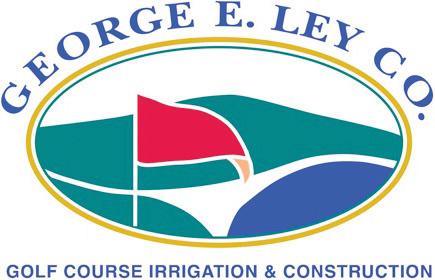


Mitra, S. S., M. Seaman, M. Fam, R. Plumb, A. Malazian, D. McKee, R. Green, K. Davidson, D.R. Huff. 2009. Evaluating new Poa annua cultivars under warmer growing conditions. USGA Turfgrass and Environmental Research Online. May 15. 8(10):1-10. http://usgatero.msu. edu/v08/n10.pdf

13 Summer 2022 • Pennsylvania Turfgrass Growth Happens Here. . BUY/SHIP DIRECT High performance liquid fertilizers, soil amendments, and every control product you need is right here under one roof. GROW YOUR BUSINESS. WE’LL GROW YOUR TURF. Healthy turf starts with Greene County Fert. Learn more: GreeneCountyFert.com Mike Kachurak ISA Certified Arborist PD-2739A 334 South Henderson Road King of Prussia, PA 19406 Office 610.265.6004 Cell 570.262.3612 mikek@shreinertreecare.com www.shreinertreecare.com 610-942-3809 Fax: 610-942-9556 • • Glenmoore, PA 19343 130 Devereux Road • Irrigation Systems • Golf Course Alterations • Field Drainage • Pump Stations • Vibratory Plowing • Pond Cleanout • Trenching • Stream Bank Stabilization • Drainage on Existing Greens gelcogolf.com
of TURFGRASS ORIGINS
 By Jay McCurdy Ph.D.
By Jay McCurdy Ph.D.
This is the first article of a multi-part series detailing the origins and future of turfgrass.
Turf consists of a layer of various plants cultivated to form a uniform ground cover, typically one that can tolerate foot traffic and routine mowing. The first known use of the word turf occurs before the 12th century and refers to the “upper stratum of soil bound by grass” (Merriam-Webster, 2022). Objectively, turf only exists in human-maintained systems; however, the species comprising various turf scenarios long predate human interference.
Those turfgrass species most frequently selected for turf scenarios have been subject to environmental pressures (notably, frequent grazing) that have selected for traits that enhance their value as turfgrasses. Valuable traits include color, texture, uniformity, growth habit, and durability under stress. Plant breeding, the introduction of non-native and exotic species, and recurrent selection for desirable traits have led to modern cultivars and varieties of turfgrass that predominate in maintained turf settings such as lawns, sports fields, golf courses, sod farms, and roadside rights-of-way.
Turfgrasses are typically narrow-leaved species of relatively short stature that are somewhat regularly mown at heights of approximately four inches or less (Thompson and Kao-Kniffin, 2017). By convention, all grasses, including turfgrasses, belong to the Poaceae family of monocotyledonous flowering plants. The monocotyledonous (monocot) clade includes grasses and grass-like flowering plants with seeds that contain only one embryonic leaf (also known as a “cotyledon”). Monocots offer few obvious advantages for turf applications, as other flowering plants in the dicotyledonous clade (having two embryonic leaves) also persist under typical mowing heights as weeds or amenity forbs within various turf scenarios.

Feature 14 Pennsylvania Turfgrass • Summer 2022
FIGURE 2. A traditional hay meadow where human interaction has selected for a complex ecosystem of grasses and forbs that can persist with very few inputs.
FIGURE 1. Turfgrasses, such as the Poa pratensis (Kentucky bluegrass) and perennial ryegrass pictured here, evolved under frequent grazing.
, Associate Professor, Turfgrass Extension Specialist • Department of Plant & Soil Sciences • Mississippi State University
NOT JUST GRASS
Turfgrasses are broadly classified as cool- or warm-season plants. Cool-season species are the predominant turfgrass species in climates with cold winters and mild summers, as well as adequate soil moisture. Warm-season species predominate in climates with mild winters and hot summers. The overlapping area between the two is termed the transition zone, where cool- and warm-season species grow equally successfully.
Cool-season species have evolved a C3 photosynthetic pathway for carbon fixation. They use an enzyme (called RuBisCO) to fix CO2. That carbon from CO2 forms a three-carbon sugar and then goes on to fuel plant growth and metabolism. Alternatively, warm-season species have evolved a C4 photosynthetic pathway that produces a four-carbon sugar. Plants with the C4 pathway
have improved metabolism and a competitive advantage over C3 plants under conditions of drought, high temperatures, and limited nitrogen or CO2
Cool- and warm-season species have different optimal temperatures for growth and metabolism. Warm-season species grow best when temperatures are above approximately 80°F and enter dormancy below their “base growth temperature” of around 50°F. Alternatively, cool-season species grow best when temperatures range from 60–75°F. Cool-season species enter a state of winter dormancy at temperatures below freezing and are often considered dormant during summer conditions that exceed their ideal growing temperatures, especially when soil moisture is limited. Growth models to predict the suitability and phenology of these species are largely based upon these parameters and estimates.

15 Summer 2022 • Pennsylvania Turfgrass
Cold Winter Humid Zone Mild Winter Humid Zone Hot Summer Arid Zone Cold Winter Arid Zone Hot Summer Humid Zone Transition Zone Semitropical Zone
Lawngrass Zones of the United States
FIGURE 3. Lawngrass zones of the United States (Freeze, 2022).
Photo Credit: Tim Freeze, CC BY-SA 4.0 <https://creativecommons.org/licenses/by-sa/4.0>, via Wikimedia Commons
There are approximately 40 million acres of turfgrass in the United States (2% of the total U.S. land cover) (Milesi et al. 2005). Several estimates suggest that residential lawns represent roughly 75% of U.S. cultivated turf (an area of approximately 30 million acres) (Roberts and Roberts, 1987; Vinlove and Torla, 1994).
EARLY LAWNS
A lawn is an area of soil-covered land planted with grasses or forbs that are maintained at a short height by mowing or grazing. Lawns may be situated in residential areas or commercial or shared public spaces. The word lawn originates from an ancient Celtic language, possibly Welsh. The Welsh word llan (pronounced ɬan, where ɬ has a slight sh sound), which is often used in compound words to describe a local place named for a saint, such as Llanbedr or St. Peter, has come to mean a cleared or enclosed area of land—perhaps around a church, business, or settlement. The common Brittonic word llan or laun came to mean an enclosure, most likely around a place of worship. Early lawns would have been used for communal gatherings and possibly grazing, although the area would have been distinct from agricultural fields. Lawns would have been composed of mixed grasses and forbs that were endemic to the area.
Lawns are frequently attributed to European origins, but their purposes (e.g., communal gatherings, periodic grazing, aesthetics, etc.) and the ingredients to manage them (low-growing species and a suitable environment) have often coincided throughout global human history. For at least many thousands of years, humans have felled trees, grazed, and gardened their immediate surroundings. This behavior partly arose from the advent of agriculture, but also serves for defense—modern gardeners can easily relate to the struggle to keep deer or rabbits from ravaging gardens. An aesthetic preference for stately grounds certainly would have developed, but could only occur when safety, time, and labor were available. Grazing would have prevented cleared land from reverting to forest, and other, previously intangible benefits of a cultivated lawn would have been noticed.
Though they may not fit neatly within the contemporary definition of a lawn, early examples of maintained open spaces as “yards” or “lawns” are fairly commonplace the world over. They include examples like the plaza between mounds at the Cahokia complex in Illinois, where the stick-and-ball sport chunkey was played 900 years ago, and Japanese gardens that incorporated manicured grasses, mosses, and even trimmed bamboo. While not unique to Europe, most scholars agree that the modern American lawn aesthetic owes much to European origins.

16 Pennsylvania Turfgrass • Summer 2022
Feature • continued
FIGURE 4. A reconstructed Anglo-Saxon lodging. Lawns would have been places for work, gathering, and grazing.
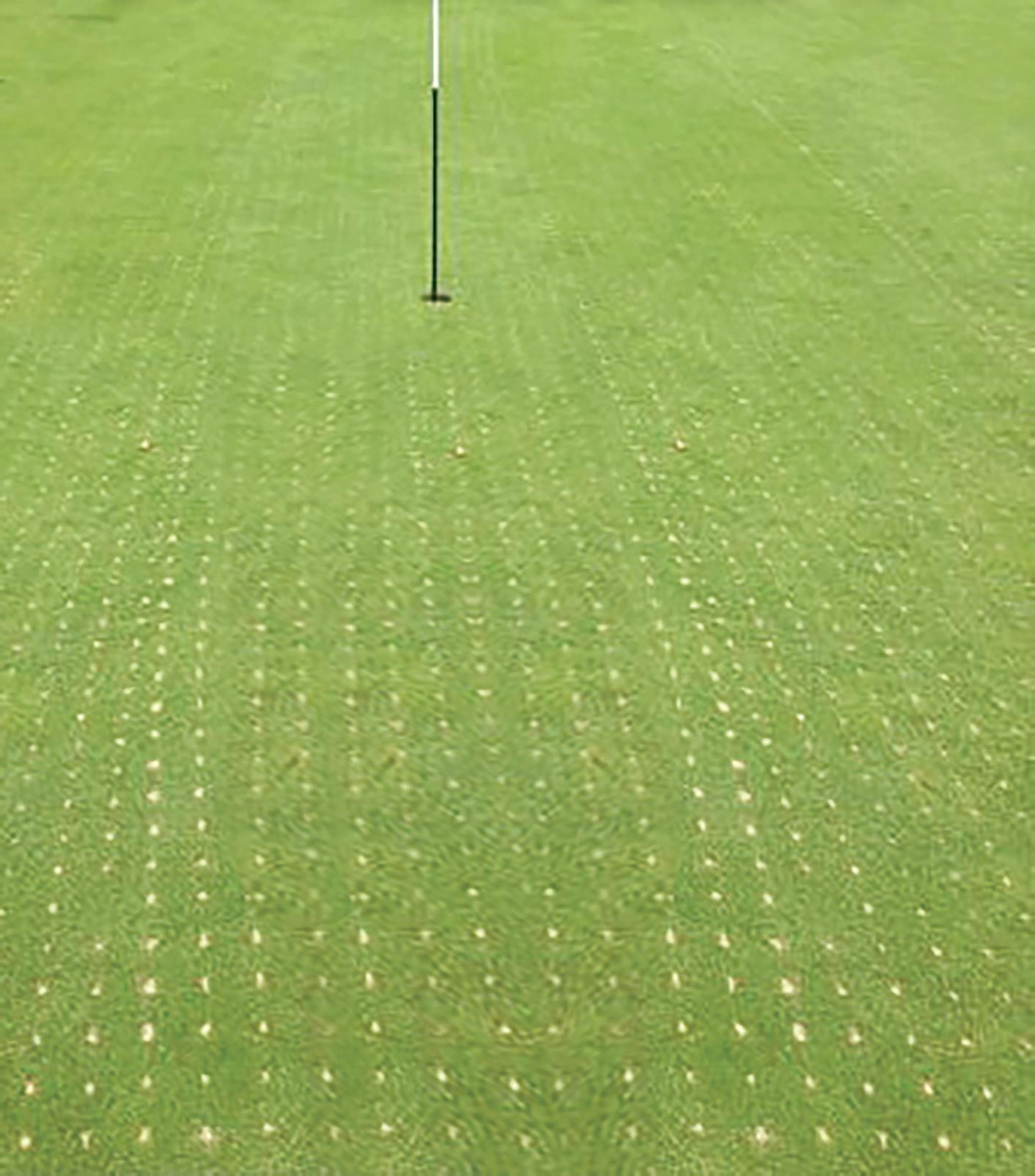
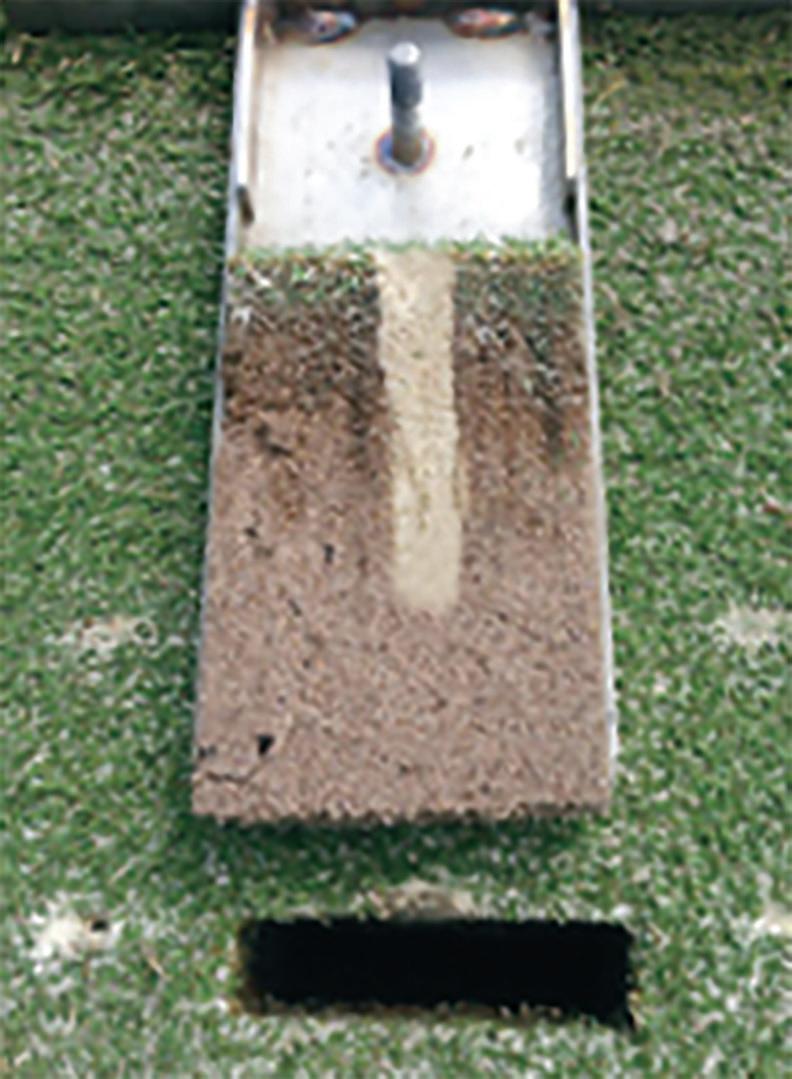
Aerate and Play Right Away! Decreased down time, increased revenue. The surface is very “puttable.” The dots are sand that is level with the turf. DryJect® is a high-pressure, water based injection system that blasts holes through the root zone and fractures the soil profile. Plus, it automatically fills holes as it aerates. DryJect® makes a big difference in playability … right away! DRYJECT.com Dryject Eastern PA Mike Zellner (484)-357-9197 mike@dryject.us Dryject Western PA Ben Little (412)-610-9001 ben.j.little@comcast.net Call Today! NO BUMPS! One hour following a DryJect® treatment. Aerate, amend and play right away
Lawns existed in Europe from the Middle Ages (in the 5th through the 15th century) onward. They were rudimentary by contemporary standards, with very practical purposes— line-of-sight for defense and communication, ease of movement, production of grain crops and vegetables, grazing, and fire prevention. Those early lawns must also have created vistas and an aesthetic that evolved with European civilization.
The European lawn of the 17th and 18th centuries was a demonstration of wealth and power at some of the continent’s finest estates. The palace of Versailles’s tapis vert or green carpet— one of Europe’s first and finest garden lawns—was expanded by André Le Nôtre to two acres in the 1660s. A century later, the lawn had been cemented as an exemplar of Western Europe’s idealized built landscape. The architect Capability Brown refined the English lawn with natural or “romantic” estate settings for wealthy clientele. His landscapes featured smooth, undulating lawns running from “house to horizon,” sometimes with dammed rivers or creeks, serpentine lakes, clumps of vegetation and scatterings of trees, and a visible horizon line. These gardens often used grazed grass lawns or pastures to supplement the
perception of scale within the landscape. In some instances, they used lines and texture to deceive the eye—employing concepts like false horizons using “ha-ha walls” or cleared land that sloped uphill and decreased in width as it reached a ridge.
During the late 18th century, wealthy families of the Americas began maintaining lawns. In 1780, a Shaker community near Philadelphia began commercializing lawn seed. Thomas Jefferson is credited with the first English-style garden in the United States, circa 1806.

MOWING LEADS TO MODERN LAWNS
Before the advent of mechanical mowers, manicured turfgrass required animal grazing or human-powered scythes. The term “mower” dates to the 14th century, referring to one who cuts grass with a scythe. The term may have multiple origins—Old English mawan and the Greek term amao both mean “to reap a crop.” In 1830, Edward Beard Budding based his mowing machine on a cloth-cutting cylinder used to trim the irregular nap of wool cloth. Thus, modern mowing equipment was born.
18 Pennsylvania Turfgrass • Summer 2022
Feature • continued
FIGURE 5. Turfgrass has transformed the aesthetic and ecology of the U.S. suburban landscape.


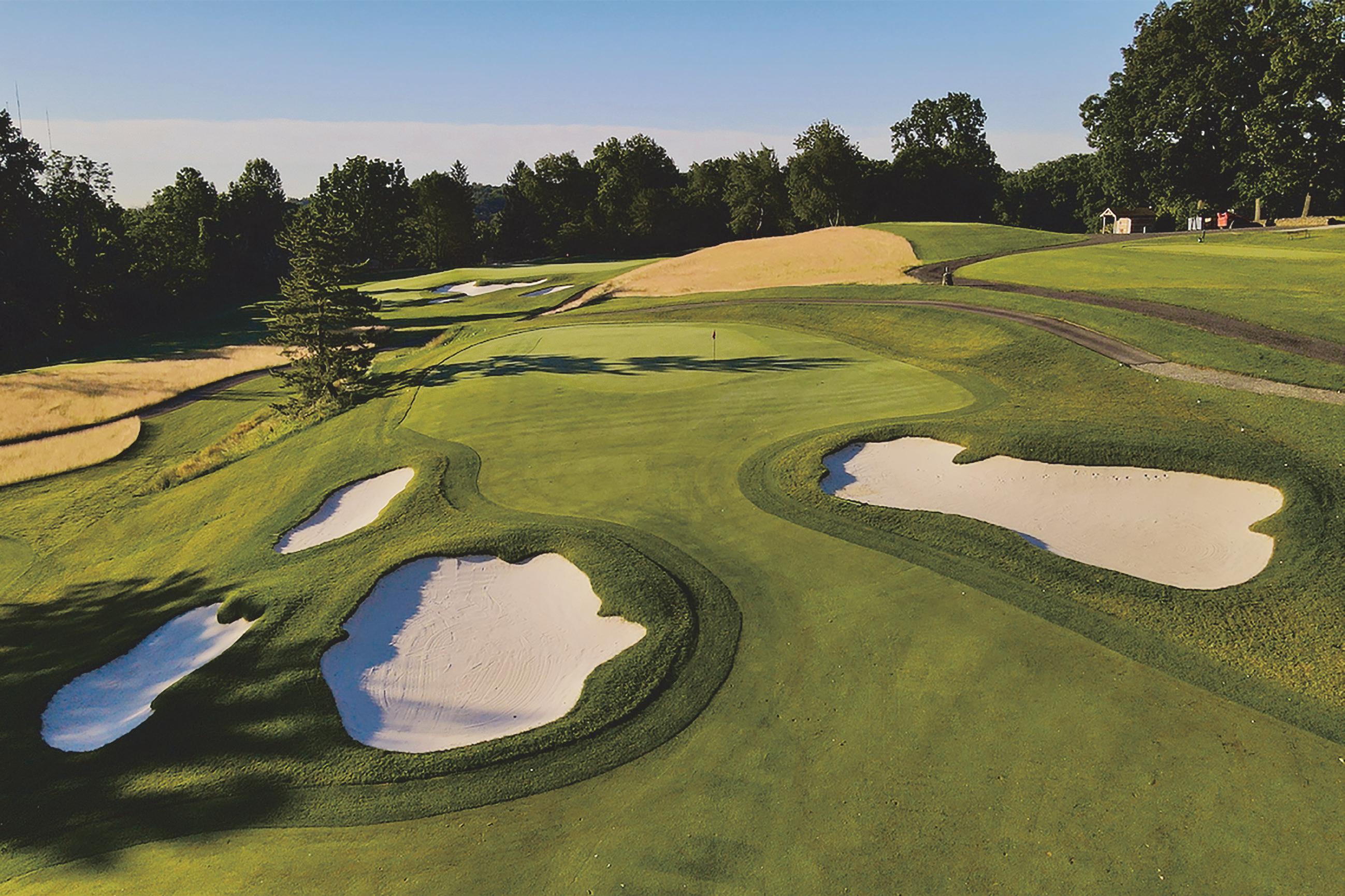 V. Halyard – Storylounge Photo
V. Halyard – Storylounge Photo
The Victorian era’s penchant for sport spurred revolutionary new mower designs to maintain sporting venues for golf, football, lawn bowls, lawn tennis, and cricket. In fact, the term “lawn-tennis” was coined in the 1880s.



Mowing is the most common practice performed on maintained turfgrass and is by most accounts the most important and defining maintenance operation. The obvious purpose of mowing is to reduce the height of the turf, but it also serves other purposes, including the control of undesirable vegetation (i.e., weeds) and the production of a desirable sports surface (e.g., a “true” putting surface or a target surface firmness).
The ability to mow large areas without tending livestock or toiling over a scythe revolutionized the grounds maintenance industry and sparked a revolution in landscape design. Modern lawns look far different from their early predecessors. Lawns have been a mainstay of the U.S. built environment since the mid-20th century, during which large tracts of land were converted into suburban housing, recreational areas, and commercial real estate. This trend, spurred by population growth, technological advancements, and other socioeconomic factors, led to a reliance on turfgrass as a ground cover for newly constructed outdoor spaces.
This is to say almost nothing of the parallel and synergistic developments of the golf industry, which we will explore in a future article. It also says little about the historical changes in schools of thought regarding urban infrastructure and the development of parks and neighborhoods that were spurred by successive waves of soldiers returning from overseas wars, the effects of the Spanish flu pandemic and city dwellers’ migration to the suburbs, or Depression-era spending on public projects that transformed the U.S. landscape and natural spaces in ways that are evident to this day.
In a future article, we will explore the concepts of landscape sustainability and “future-proofing” for the modern turfgrass economy. In much of the U.S. and around the world, rooftops, parking lots, busy city streets, and home lawns are replacing natural habitats. These systems have, for better and worse, changed how we interact with, build, and perceive our environment. Turf is just one result of these changes.
Merriam-Webster. (n.d.). Turf. In Merriam-Webster.com dictionary. Retrieved June 27, 2022, from https://www.merriamwebster.com/dictionary/turf
Milesi, C., Running, S.W., Elvidge, C.D., Dietz, J.B., Tuttle, B.T., & Nemani, R.R. (2005). Mapping and modeling the biogeochemical cycling of turf grasses in the United States. Environmental Management. 36(3), 426-38.
Roberts, E.C., and Roberts, B.C. (1987). Lawn and Sports Turf Benefits. Pleasant Hill, TN: The Lawn Institute. 31.
Thompson, G. L., & Kao-Kniffin, J. (2017). Applying biodiversity and ecosystem function theory to turfgrass management. Crop Science, 57(S1), S-238.
Vinlove, F. K., & Torla, R. F. (1994). Comparative estimations of US home lawn area. Journal of Turfgrass Management, 1(1), 83-97.
Feature • continued 20 Pennsylvania Turfgrass • Summer 2022
FIGURE 6. An early push propelled mower with an eight-inch blade width.
FIGURE 7. A horse drawn reel mower.
FIGURE 8. 1920s and ’30s-era walking mowers on display.


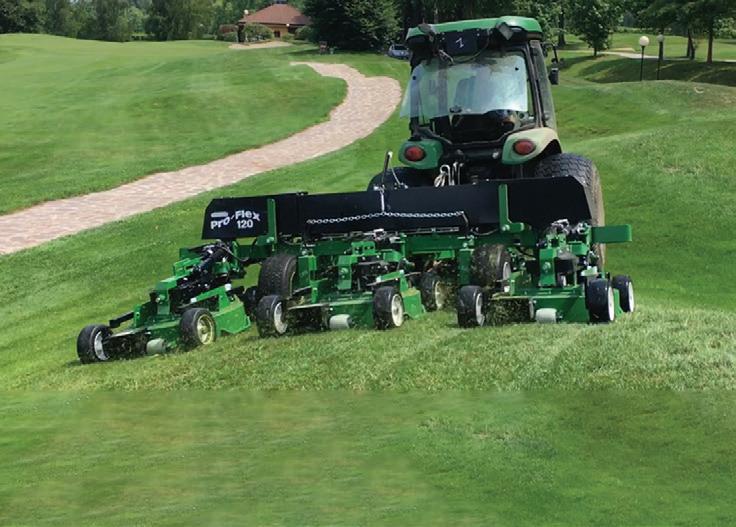
21 Summer 2022 • Pennsylvania Turfgrass WWW.PROGRESSIVETURFEQUIP.COM 800.668.8873 Better Built. Quality Results. Period. Quality built in North America and supported by a world-wide Dealer network. Tri-Deck cutting widths: 12’, 15.5’, 22’*, 36’* Roller Mower cutting widths: 65”, 90”, 10.5’, 12’, 15.5’, 22’*, 29.5’* Contour/rough finishing mower: Pro-Flex™ 120B 10’ cut TDR-X™ roller mower 10.5’ cut Progressive Turf builds the right mowers and rollers for any field. For over 30 years they have set and re-set the standards in commercial grade mowing equipment. Contact your Progressive Dealer to find out why Progressive products are outstanding in any field! * available with bolt-on galvanized deck shells
Turf Grass Production Mowers
Contour / Rough Finishing Mowers
Sports field, Park and Estate Mowers
New Turfgrass Science Textbook from Penn State!
Theturfgrass industry is facing increasing pressure to reduce its environmental impact and advance more sustainable maintenance practices that better utilize and/or optimize agronomic-related resources. Achieving Sustainable Turfgrass Management is a new turfgrass science book, edited by Dr. Mike Fidanza (Penn State – Berks Campus). This book summarizes the wealth of recent research that addresses these challenges:
• Reviews the impact of climate change on the increasing threat of biotic and abiotic stresses to the turfgrass industry, as well as the challenge of treating diseased turf in the face of fungicide resistance.
• Considers the development of alternative, more sustainable management practices that utilize and/or optimize fewer agricultural outputs, such as fertilizers, pesticides, and energy.
• Provides a selection of case studies that detail the establishment of good turfgrass management and maintenance in a variety of environments (golf courses, athletic fields, sports pitches, arid environments).

This textbook contains 20 chapters:
Part 1 — Physiology, breeding and cultivation
1. Advances in understanding turfgrass physiology.
2. Advances in breeding for improved cultivars of turfgrass.
3. Advances in soil management for successful establishment and maintenance of turfgrass.
4. Advances in phosphite utilization for turfgrass.
5. Advances in irrigation and water management of turfgrass.
6. Advances in maintenance practices of turfgrass.
7. Advances in turfgrass for athletic fields and sports pitches.
8. Advancements in turfgrass for ornamental lawns.
Part 2 — Biotic and abiotic stresses
9. Advances in turfgrass disease management.
10. Advances in turfgrass insect pest management.
11. Advances in turfgrass weed management.
12. Advances in plant growth regulation in turfgrass.
13. Advances in abiotic stress management in turfgrass.
14. Advances in managing organic matter in turfgrass ecosystems.
15. Advances in biostimulants in turfgrass.
Part 3 – Case Studies
16. Considerations with using unmanned aircraft systems in turfgrass.
17. Considerations with selecting turfgrass varieties and cultivars.
18. Considerations with turfgrasses and pollinators.
19. Considerations with water for turfgrass in arid environments.
20. Considerations with soil testing in turfgrass.
“The 3 E’s of Sustainability (Environment, Economics, EthicalSocial Impacts) in all their forms continue to underpin the values and goals of professional turf managers across the globe who strive to build and maintain healthy, long-term communities where parks, lawns, sports fields and golf course turfs are the dominant vegetation. As global populations grow, annual climate vagaries increase, and biotic and abiotic plant stresses become more uncertain it is now more important than ever to understand how factors like species selection, edaphic conditions and cultural management decisions influence the ecology and persistence of managed turf systems. In this comprehensive book, Dr. Mike Fidanza has compiled industry leading turf experts who provide relevant, fact-based insights across an array of key topics to help turf managers meet their modern management goals.” (Dr Cale Bigelow, Professor of Turf Science and Ecology, Purdue University, USA).
Penn State News 22 Pennsylvania Turfgrass • Summer 2022
TO ORDER THE TEXTBOOK: https://www.bdspublishing.com 20% Discount: Enter Code TGRASS20
Save the Date! • PENN STATE FIELD DAY • August 1, 2023 • University Park
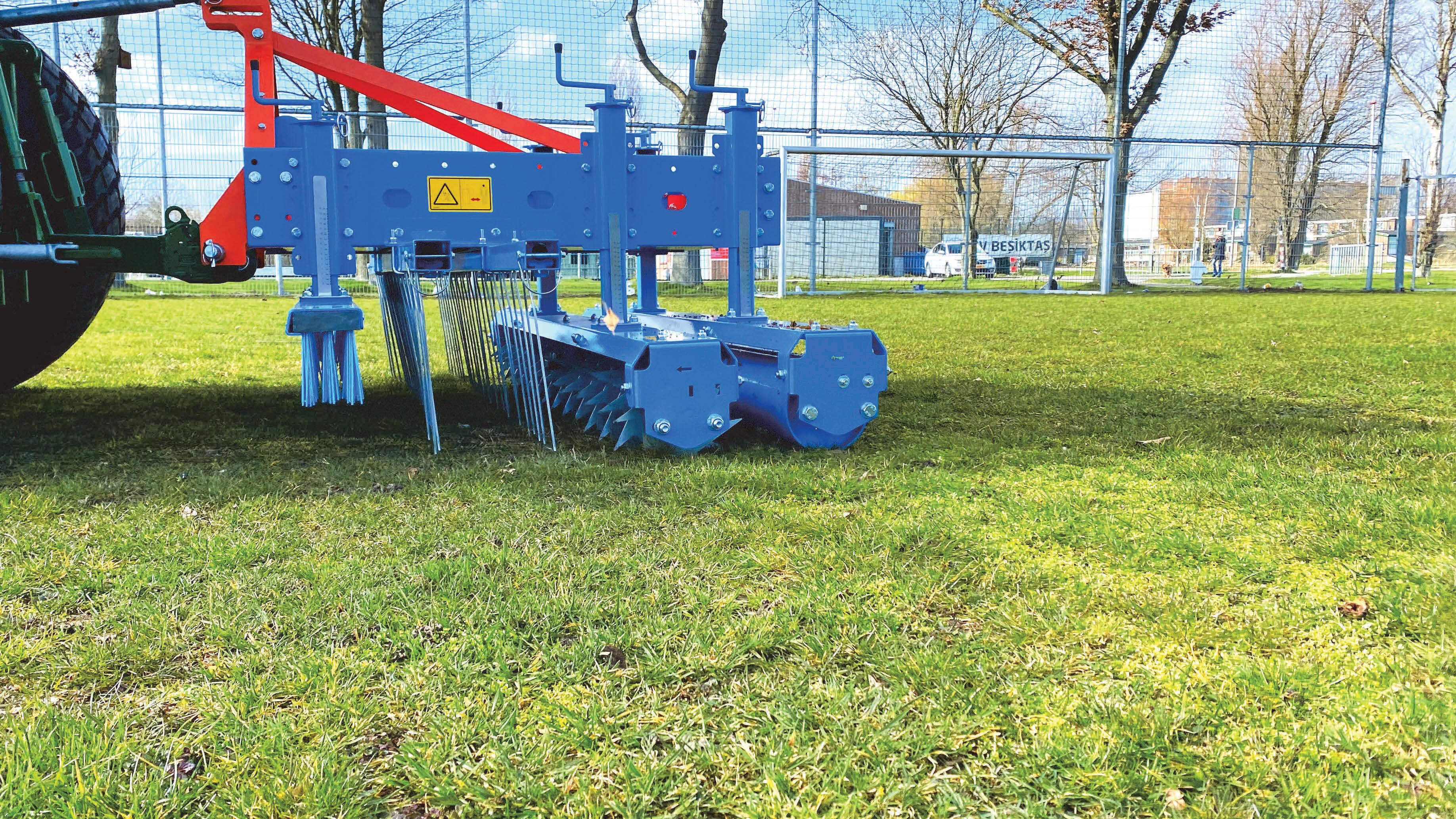
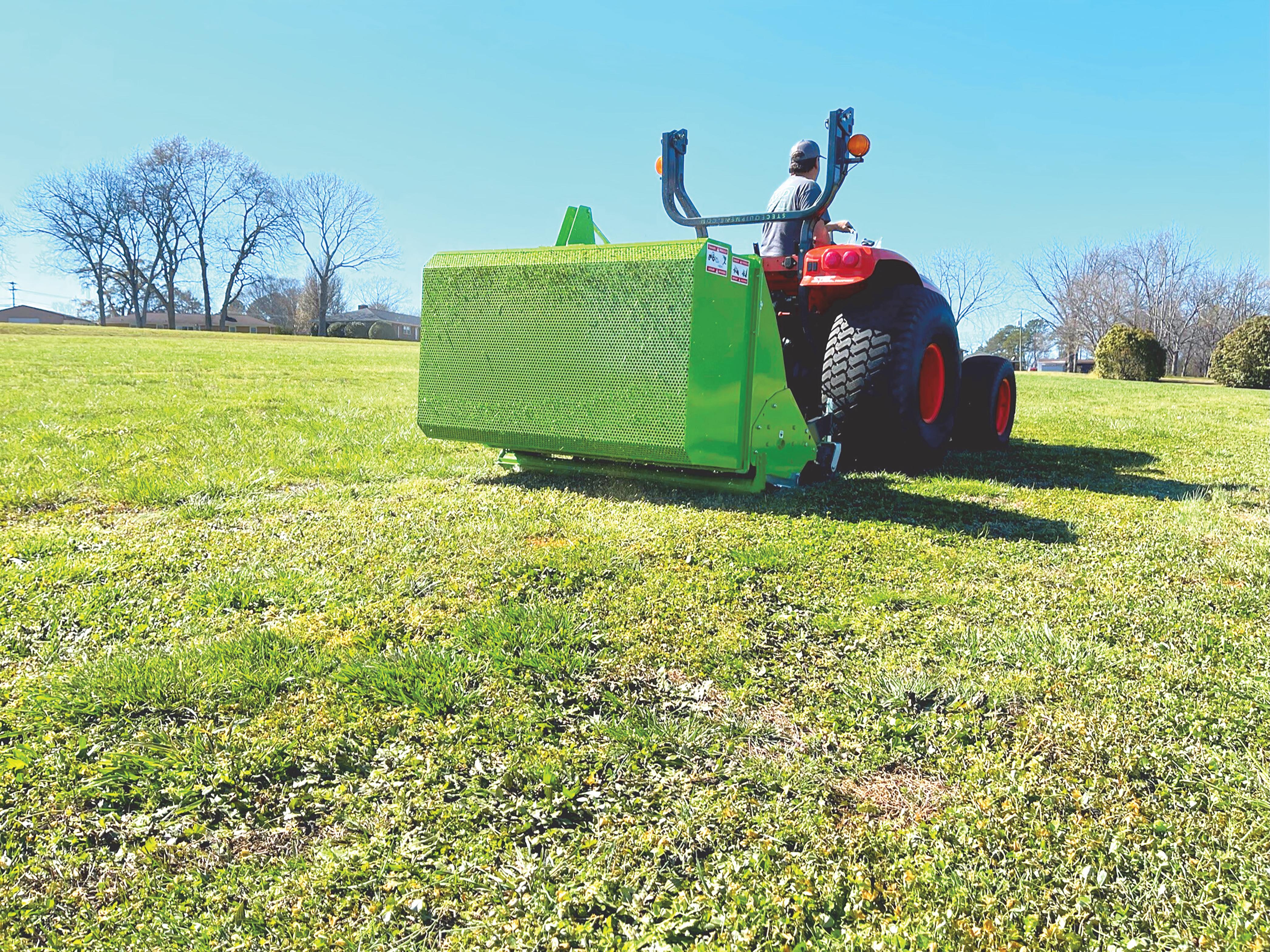
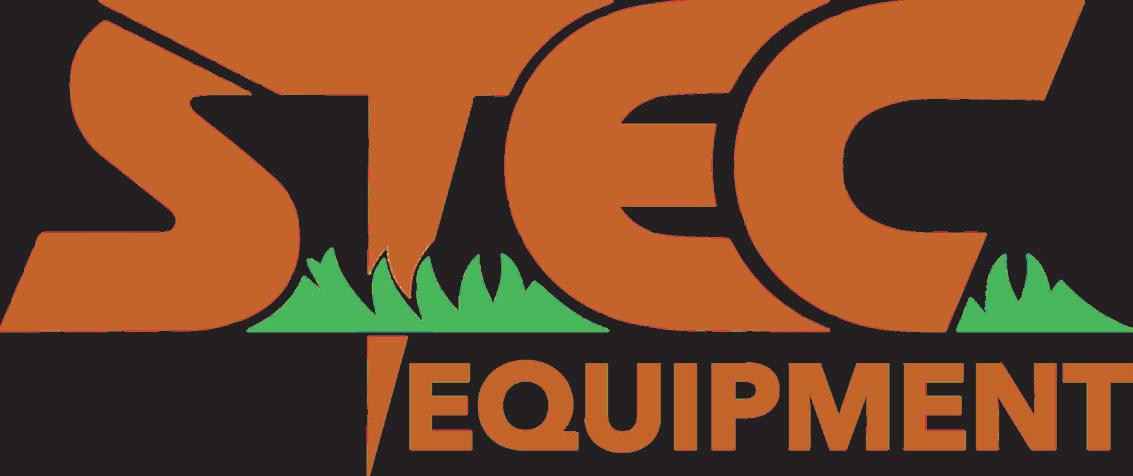

VERTICUT DETHATCH & COLLECT GKB COMBITOOL STEC FVC130 WWW.STECEQUIPMENT.COM (888) 325-2532
Historic Bowman Field Earns 2023 Field of Distinction Award
Every year at the annual KAFMO Athletic Field Conference in February, KAFMO recognizes sports facilities that have been dedicated to providing safe, playable conditions for their users, regardless of the level of play. The 2023 Field of Distinction awards went to East Pennsboro Area School District, John Gross Field and to the Williamsport Crosscutters, Muncy Bank Ballpark at Historic Bowman Field. We caught up with Cam Richardson, head groundskeeper for the Williamsport Crosscutters, and asked him about the experience. “In the years that I have been working at this facility we have always gotten compliments on the playing surface. It’s always good to hear compliments,” he said, “but recognition by your peers is a great honor!”
MLB STANDARD
Cam has worked for BrightView Landscapes, MLB’s official field consultant, since 2019 after six years of experience in sports turf maintenance in Georgia, Maryland, and New York. He decided to nominate Muncy Bank Ballpark at Historic Bowman Field for recognition following major renovations in 2017 and again in 2020, which brought the second-oldest minor league ballpark in the country up to MLB’s exacting field standards. “The fields always have to be pristine and 100 percent perfect. I knew that was the standard here,” Richardson said, “and I am proud to maintain an MLB-standard field.”


Bowman Field first opened in 1926 and underwent $4 million in upgrades under the guidance of BrightView and MLB ahead of the 2017 season: new seating, bullpens, dugouts and a premium deck along the first base line. MLB also committed to the installation of a Major League playing surface and an irrigation and drainage system. A further renovation in the fall of 2020 consisted of stripping the infield and 30 feet into the back arc to improve the grade of the infield skin to a -.4% slope in order to mitigate drainage issues.
CHALLENGES AND SOLUTIONS
From 1926 to 2017 Bowman Field was a native soil field. In 2017 it was rebuilt on 100% sand and resodded, first with All Pro Bluegrass sod and then in 2020 with 365SS Bluegrass. Richardson notes that drainage and irrigation have been some of the facility’s biggest challenges. During the 2017 renovation, new drainage pipe which runs to a collector that is looped around the whole field was installed into the gravel sub-grade. A new irrigation system was installed in the field as well. The field was built with a conventional Rainbird system consisting of 13 zones and new Rainbird PEB valves and a new booster pump were installed in the fall of 2019. There are plans to install a VFD in the Spring of 2023 to help limit water hammer on the valves.
Contact: Dan Douglas, President Phone: 610-375-8469 x 212 KAFMO@aol.com Contact: Linda Kulp, Executive Secretary Phone: 717-497-4154 kulp1451@gmail.com Keystone Athletic Field Managers Organization 1451 Peter’s Mountain Road Dauphin, PA 17018-9504 www.KAFMO.org • Email: KAFMO@aol.com BETWEEN THE LINES 24 Pennsylvania Turfgrass • Summer 2022
Cam Richardson
BUSY SEASON
Muncy Bank Ballpark at Historic Bowman Field is a dedicated baseball field that hosts players from the MLB Draft League, college, high school, and softball teams. The MLB Draft League consists of amateur players playing to improve their draft status for the MLB draft for the first half of the season, followed by a second team playing independent baseball. But “our most renowned athletes play on the field during the MLB Little League Classic. Last year we hosted the Red Sox and Orioles!” Richardson says with pride. The MLB Little League Classic in August is the facility’s best-known event. Both MLB and BrightView want to make sure that the Little Leaguers have the best experience possible and that includes having a great field for the players to play on. “The MLB standard is held all year round, but we spend extra time and energy in the weeks leading up to the game to make sure everything is perfect,” says Richardson.
Even though the MLB Little League Classic is the highlight, Bowman Field also hosts many other events throughout the year. The Crosscutter’s season runs from June to September with 40 games as well as practices. Pennsylvania College of Technology’s division III baseball program makes Bowman Field its home for all the home games. and high school games include regular season games and a local 4-team tournament. Bowman Field also hosts 6 PIAA playoff games, including
district championships, as well as the first round of state playoff tournament. All in all, Bowman Field played host to 78 events in 2022.
Cam Richardson works at the field year-round. In 2022 during the busy season of March through November, he was supported by Seasonal Assistant Groundskeepers Ben Heemstra (PSU ’25) and Ryan Daub (PSU ’25). It was Ben’s second year working for the team and Ryan’s first year. The seasonal assistants gain valuable hands-on experience with all aspects of turf maintenance. “Fertilizing, aerating, mowing, top-dressing — we do everything we can to help this field perform to the best of its ability,” Richardson said. The experience they gained while interning at Bowman Field helped Heemstra and Daub secure internships with the Phillies and the Eagles for next year.
“IS THAT GRASS FAKE?”
When asked what his proudest moments as groundskeeper at Bowman Field have been, Cam Richardson laughs. “Compliments from the coaches, players, staff, and fans are always appreciated, but I have to say that my favorite thing to hear must be when fans will ask us if the grass is fake. That’s when I know that the field is looking perfect! The second thing is when a visiting team comes into the ballpark, and they look at the field in awe and disbelief. The players will ask me if they can take pictures, and I always tell them yes. Then I yell at them to get off my grass!”

25 Summer 2022 • Pennsylvania Turfgrass
ARE YOU A KAFMO MEMBER WITH A FIELD TO BE PROUD OF? You are encouraged to consider applying for a Field of Distinction award. The application process is straightforward and the peer recognition and networking opportunities gained through a KAFMO award are invaluable. Winners receive a plaque, press coverage, KAFMO apparel for two staff members, and a complimentary KAFMO Athletic Field Conference registration. You can find details at www.kafmo.org
Muncy Bank Ballpark
The Manager’s Dilemma
By Neal Glatt , GrowTheBench.com
“We
have a dilemma” is how one of my employees, ten days into managing her first direct report ever, started the conversation. The issue was that there were some concerns about the work her new employee, who started with the company only ten days previously, had just submitted. It wasn’t that the work was wrong or necessarily bad, but it was certainly a bit different than the typical work we do.
Much to my manager’s credit, she told me that she wanted to give feedback but was concerned about how it would be received. Should she encourage the initiative, excitement, and action of the new employee by accepting the work as it was submitted? Or should she enforce the quality standards of work at our company by correcting the new employee?
In fact, every manager faces this dilemma on the job. How can an employee’s engagement be increased while providing constructive criticism? A manager who picks one or the other usually has mediocre team prone to expensive employee turnover. Yet often trying to pick a middle-of-the-road approach leads to neither objective being realized.
There are three pitfalls managers are subject to which leads to this situation. By taking action, they can avoid the problem and engage high-performing employees who produce great work.
LACK OF TRAINING
The reason employees typically don’t perform to the standards expected is because they simply were never taught effectively. Training isn’t something that happens once but rather must be ongoing. The best organizations and teams realize that in a rapidly changing business environment there must be continuous learning from trainers who can add new value.
My first-time manager recognized this issue immediately and told me that while she had trained her new employee on how to technically create the work, she had been planning to have a conversation around the quality and specifics in the coming days. This absolutely explains why the work done wasn’t exactly what had been expected. More training would have prevented the dilemma in the first place.
LACK OF TIME
Unfortunately, the demand of most workers today is to do more work in less time. For both employees and managers, finding the time to adequately train while meeting all their other daily obligations is difficult. Yet by expecting production too soon, it leads to greater issues than extending deadlines would have. Most managers realize only when it’s too late that by not slowing down, they lose employee engagement and limit the potential of future production forever.
Our new employee was so excited to get started working that my first-time manager gave her the green light to get started. Yet if she had extended more time for the project, she could have easily allowed the new employee to create a draft and meet for a scheduled review discussion where feedback would have been expected and easily received. If those expectations were in place, and the time constraints lifted, she would not have landed in the current predicament.
LACK OF TRUST
The type of critical feedback that managers often want to deliver is never an issue when their employees trust them implicitly. People greatly care about the intentions of those who give them feedback and these intentions become known from competence, consistency, and character demonstrated throughout a relationship. Managers can build more trust through frequent and transparent conversations which back up consistency between values, intentions, and outcomes.
For my first-time manager, I could deliver a criticism via text with no negative engagement ramifications because there is a high level of trust built over years of working together. But her dilemma was caused because it’s impossible to have this level of confidence in another person after only ten days on the job. As a result, this issue became a true dilemma and navigating the conversation successfully required care and expertise.
In the end, my first-time manager succeeded in achieving both outcomes of employee engagement and high quality, a testament to her sharp intuition as well as the care she has for both the company and her direct report. But this result was only possible with much effort and time because the manager’s dilemma is not an easy one to navigate. Most of all, she learned a valuable lesson that will help her plan for the training, time, and trust, to avoid these situations in the future.
Professional Development 26 Pennsylvania Turfgrass • Summer 2022
Neal Glatt is the Managing Partner of GrowTheBench, an online training platform for the green industry. You can learn more about him and his solutions at NealGlatt.com.
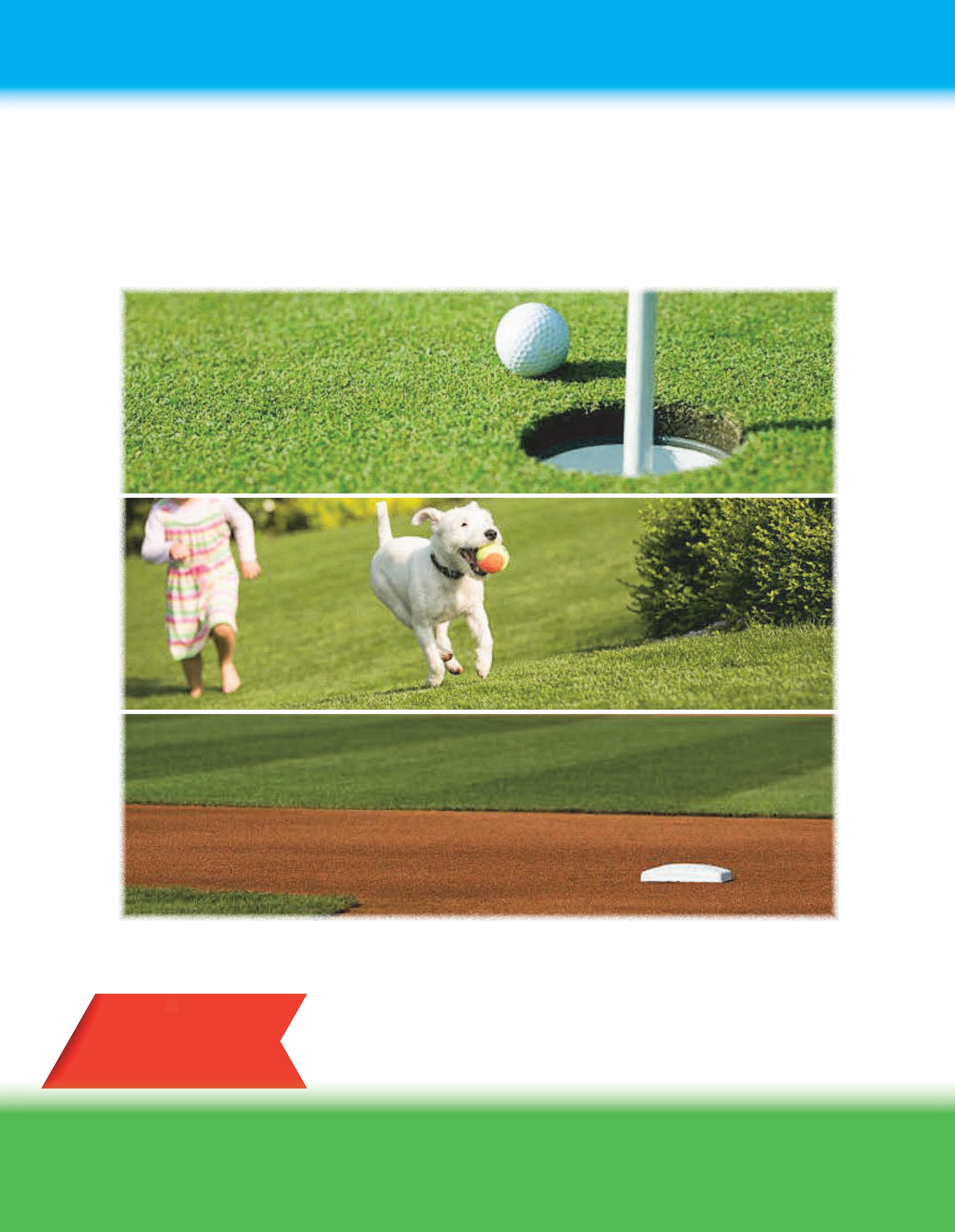




Your #1 Green Supplier Serving Eastern Pennsylvania, New Jersey, Delaware, Maryland, New York & Southern Connecticut. 856•478•6704 www.THETURFTRADE.COM Fertilizers • Wetting Agents • Fungicides • Herbicides • Insecticides Seeds • Soils • Equipment • Much More! WE’RE HIRING REGIONAL SALES SPECIALIST For More Info, please see the job listing on our LinkedIn page or email to info@theturftrade.com
More Than the Logo!


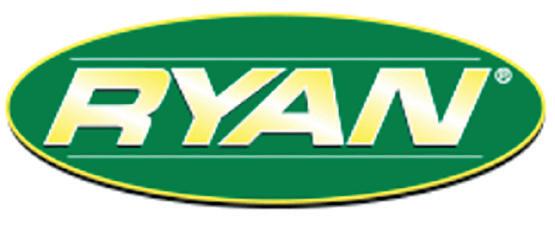
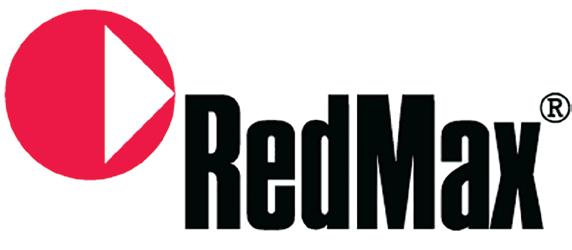
EVERYTHING TURF!
traqnology














































 By Jay McCurdy Ph.D.
By Jay McCurdy Ph.D.






 V. Halyard – Storylounge Photo
V. Halyard – Storylounge Photo

























